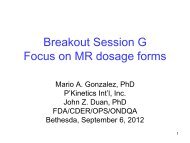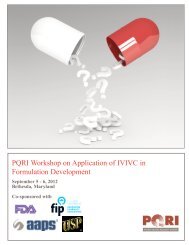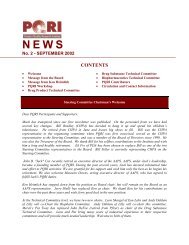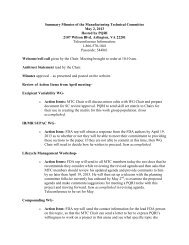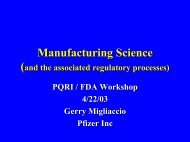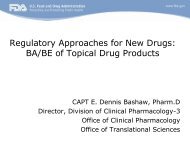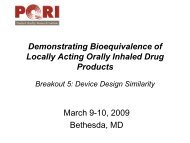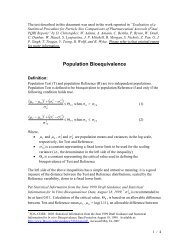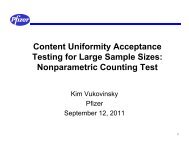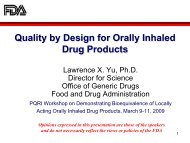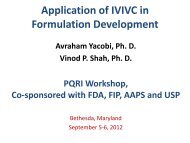Determination of Water Vapor Transmission Rate for Various ... - PQRI
Determination of Water Vapor Transmission Rate for Various ... - PQRI
Determination of Water Vapor Transmission Rate for Various ... - PQRI
Create successful ePaper yourself
Turn your PDF publications into a flip-book with our unique Google optimized e-Paper software.
<strong>Determination</strong> <strong>of</strong> <strong>Water</strong> <strong>Vapor</strong> <strong>Transmission</strong> <strong>Rate</strong> <strong>for</strong> <strong>Various</strong> High Barrier<br />
Blister Packs<br />
Executive Summary<br />
<strong>Water</strong> <strong>Vapor</strong> <strong>Transmission</strong> <strong>Rate</strong> (WVTR) testing was per<strong>for</strong>med to construct weight gain<br />
pr<strong>of</strong>iles due to moisture ingress <strong>of</strong> <strong>for</strong>med and sealed blisters (PVC, PVDC, Aclar Ultrx 2000<br />
and cold <strong>for</strong>m foil) when stored at 23°C/75% and 40°C/75% RH. The purpose <strong>of</strong> the test was to<br />
determine the potential to improve USP by determining the time needed to reach steady<br />
state, the duration, and number <strong>of</strong> data points needed <strong>for</strong> WVTR calculation, the variability in<br />
data due to samples and testing labs, and to determine if empty blisters (i.e. “controls”) are<br />
needed <strong>for</strong> accurate WVTR determination. This report summarizes the data collected from four<br />
testing labs - Merck, Pfizer, san<strong>of</strong>i-aventis and Abbott Labs. Mean WVTR results determined by<br />
linear regression without zero time point is given in the following table:<br />
Table 1<br />
WVTR Means (mg/cavity/day)<br />
Condition Site PVC PVdC Ultrx Cold<br />
23C/75%RH AB 1.215 0.185 0.029 0.005<br />
MK . 0.138 0.028 0.003<br />
PF 1.223 0.127 0.028 -0.001<br />
SA 1.280 0.142 0.028 -0.004<br />
40C/75%RH AB 2.978 0.789 0.136 0.011<br />
MK . 0.791 0.137 0.003<br />
PF 3.183 0.882 0.152 0.008<br />
SA 3.019 0.841 0.144 -0.007<br />
The primary findings are as follows:<br />
<br />
<br />
<br />
<br />
<br />
<br />
<br />
<br />
Steady state appears to be established after the second time point (first time point after<br />
initial) with the exception <strong>of</strong> PVC.<br />
The recommended time duration <strong>for</strong> testing is 2 days <strong>for</strong> PVC and 35 days <strong>for</strong> barrier<br />
blisters .1 .<br />
The recommended number <strong>of</strong> test points is 2 <strong>for</strong> PVC and 5 time points <strong>for</strong> barrier<br />
blisters.<br />
The controls have little effect on the WVTR and can be safely eliminated.<br />
Some blister types and the controls show a higher increase in moisture from the first time<br />
point (at time ‘0’) to the second time point than over the remaining time points.<br />
There is noticeable curvature in the PVC weights over time.<br />
There is no change over time in cold <strong>for</strong>m blisters.<br />
For each blister type, site slopes are similar.<br />
1 Throughout this paper, blisters <strong>for</strong>med from PVdC, Aclar, and cold <strong>for</strong>m foil are referred to as barrier blisters, as<br />
distinguished from PVC blisters.<br />
1
Both conditions <strong>of</strong> 23C/75%RH and 40C/75%RH discriminate between the blister types<br />
with better discrimination at the higher temperature.<br />
Based on the results <strong>of</strong> this study, we recommend:<br />
The use <strong>of</strong> 40ºC/ 75% RH storage condition based on reduced variability as measured by<br />
RSD.<br />
The use <strong>of</strong> the ASTM E 96 calculator to ensure a constant partial moisture vapor pressure<br />
differential, determine the required number <strong>of</strong> blisters and balance sensitivity to ensure<br />
data precision and accuracy. Refer to Appendix 1.<br />
A test duration <strong>of</strong> 2 days <strong>for</strong> PVC and 35 days <strong>for</strong> barrier blisters at 40ºC/ 75% RH.<br />
The use <strong>of</strong> 2 time points <strong>for</strong> PVC at initial and day 2 and the use <strong>of</strong> 5 (weekly) time<br />
points <strong>for</strong> barrier blisters beginning at day 7. Eliminate the initial time point (time ‘0’)<br />
<strong>for</strong> barrier blisters.<br />
Eliminate the use <strong>of</strong> empty controls when using non-paper backed lidding foil.<br />
The use <strong>of</strong> linear regression <strong>for</strong> calculating WVTR <strong>for</strong> barrier blisters.<br />
Report results in mg/day/blister cavity and eliminate reference to blister classification to<br />
enable comparison with other container closure systems (e.g. bottles).<br />
Introduction & Objectives<br />
The purpose <strong>of</strong> this study was to assess the opportunity to improve USP by constructing<br />
the weight gain pr<strong>of</strong>iles, due to moisture ingress, <strong>of</strong> <strong>for</strong>med and sealed blisters when stored at<br />
23°C/75% and 40°C/75% RH. The pr<strong>of</strong>iles were used to determine the time needed to reach<br />
steady state, the duration, and number <strong>of</strong> data points needed <strong>for</strong> <strong>Water</strong> <strong>Vapor</strong> <strong>Transmission</strong> <strong>Rate</strong><br />
(WVTR) calculation, the variability in data due to samples and testing labs, and to determine if<br />
the empty blisters (i.e. the “control”) are needed <strong>for</strong> accurate WVTR determination. The origins<br />
<strong>of</strong> this study also lie in part in a previous publication 1 that provided a theoretical basis <strong>for</strong> using<br />
WVTR per unit dose as a means to compare different container-closure systems.<br />
Materials & Methods<br />
Blisters were <strong>for</strong>med and filled with an appropriate amount <strong>of</strong> desiccant (or without desiccant in<br />
the case <strong>of</strong> controls) determined using the ASTM E 96 calculator described in Appendix 1, and<br />
sealed to a heat sealable foil lid structure according to established procedures. Subsequently, the<br />
blister samples were stored in environmental chambers controlled at 40±2°C/75±5%RH or<br />
23±2°C/75±3%RH. Each individual container (blister pack or set <strong>of</strong> blister packs) was weighed<br />
at various time points throughout the study according to a study protocol as summarized in<br />
Appendix 2. The weights <strong>of</strong> the blisters were tabulated <strong>for</strong> statistical analysis and <strong>for</strong><br />
determination <strong>of</strong> WVTR (in mg per day per blister cavity) <strong>for</strong> the specific blister types (material<br />
& cavity design) at the two testing conditions. A linear line <strong>of</strong> best fit was applied to the weight<br />
data <strong>for</strong> each container using linear regression. The slope <strong>of</strong> each line is the WVTR.<br />
2
Four blister types were used in the study: (1) 200 µ PVC, (2) 200 µ PVC/ 60 gsm PVdC, (3) 200<br />
µ PVC/ 51 µ Aclar, and (4) cold <strong>for</strong>m foil. The lidding foil was 20 µ Push-Thru, without paper<br />
or supporting film. Details on test duration, weighing intervals, amount <strong>of</strong> desiccant, number <strong>of</strong><br />
cards, number or replicates, etc are given in Appendix 2. The blisters were <strong>for</strong>med on a Pentapak<br />
CT1200 using toolings designed to accommodate a size ‘0’ capsule. Four labs per<strong>for</strong>med the<br />
WVTR testing: Merck (MK), Pfizer (Pf), san<strong>of</strong>i-aventis (SA), and Abbott (AB).<br />
Results/Discussion<br />
A number <strong>of</strong> containers (n=17 <strong>of</strong> a total 300 blister cards) were removed from the analysis due to<br />
holes found in the blisters. All <strong>of</strong> these containers contained desiccant. Merck did not per<strong>for</strong>m<br />
the PVC testing. Storage conditions were reversed <strong>for</strong> the Abbott blisters during days 15-17.<br />
As can be seen in Appendix 2, the number <strong>of</strong> blister packs was not consistent across the four<br />
blister types. To compare across blister types, results were converted to mg/cavity. Note that<br />
<strong>for</strong> PVC, AB per<strong>for</strong>med two runs <strong>of</strong> 5 containers apiece denoted AB1 & AB2 in the figures.<br />
Summary<br />
The weight and the calculated WVTR <strong>for</strong> each blister type are given in the following subsections<br />
(A-D). Each subsection consists <strong>of</strong> two figures followed by a slope summary table.<br />
Figure descriptions:<br />
Figure #1:<br />
Figure #2:<br />
Mean weight (mg/cavity) <strong>of</strong> 10 containers with desiccant at each time point by<br />
lab. Blisters were stored at 23C/75%RH.<br />
Mean weight (mg/cavity) <strong>of</strong> 10 containers with desiccant at each time point by<br />
lab. Blisters were stored at 40C/75%RH.<br />
Slope Summary Table Description<br />
For each container type, there are two sets <strong>of</strong> results within the slope summary table. Each set<br />
provides the number <strong>of</strong> slopes (containers) used in the calculation, the mean, standard deviation,<br />
and RSD(%) <strong>of</strong> the slopes as well as the minimum and maximum slope <strong>for</strong> each site and<br />
condition. The two sets are: 1) Containers with desiccant and 2) Containers with desiccant after<br />
adjusting <strong>for</strong> the mean <strong>of</strong> the empty controls (i.e., At each time point, the mean <strong>of</strong> the empty<br />
controls (usually n=10) was subtracted from the weight <strong>of</strong> each container containing desiccant<br />
prior to fitting the linear regression line to determine the WVTR).<br />
3
A) PVC<br />
Figure A1 Figure A2<br />
23C/75% RH 40C/75%RH<br />
Table A<br />
PVC Blisters<br />
Slope Summary Statistics<br />
Set 1 - As Is Mean Std Dev Minimum Maximum<br />
Condition Site N (mg/cavity/day) (mg/cavity/day) RSD(%) Slope Slope<br />
23C/75%RH AB 10 1.2230 0.0103 0.8402 1.2086 1.2371<br />
23C/75%RH PF 10 1.2313 0.0167 1.3552 1.2107 1.2690<br />
23C/75%RH SA 10 1.2943 0.0088 0.6803 1.2840 1.3074<br />
40C/75%RH AB 10 3.0820 0.0973 3.1586 2.8903 3.2236<br />
40C/75%RH PF 10 3.2391 0.0387 1.1957 3.1858 3.2951<br />
40C/75%RH SA 9 3.1387 0.0919 2.9282 2.9230 3.2429<br />
Set 2 (Adjusted <strong>for</strong> Controls) Mean Std Dev Minimum Maximum<br />
Condition Site N (mg/cavity/day) (mg/cavity/day) RSD(%) Slope Slope<br />
23C/75%RH AB 10 1.2241 0.0101 0.8279 1.2090 1.2375<br />
23C/75%RH PF 10 1.2256 0.0167 1.3615 1.2049 1.2633<br />
23C/75%RH SA 10 1.2901 0.0088 0.6826 1.2798 1.3032<br />
40C/75%RH AB 10 3.0807 0.0966 3.1368 2.8899 3.2213<br />
40C/75%RH PF 10 3.2297 0.0387 1.1992 3.1763 3.2856<br />
40C/75%RH SA 9 3.1330 0.0919 2.9335 2.9174 3.2372<br />
4
B) PVdC<br />
Figure B1 Figure B2<br />
23C/75% RH 40C/75%RH<br />
Table B<br />
PVdC Blisters<br />
Slope Summary Statistics<br />
Set 1 - As Is Mean Std Dev Minimum Maximum<br />
Condition Site N (mg/cavity/day) (mg/cavity/day) RSD(%) Slope Slope<br />
23C/75%RH AB 10 0.2067 0.0307 14.855 0.1869 0.2671<br />
23C/75%RH MK 10 0.1448 0.0010 0.674 0.1425 0.1458<br />
23C/75%RH PF 10 0.1366 0.0078 5.736 0.1150 0.1407<br />
23C/75%RH SA 10 0.1464 0.0006 0.435 0.1453 0.1472<br />
40C/75%RH AB 10 0.8207 0.0137 1.663 0.7887 0.8366<br />
40C/75%RH MK 10 0.8277 0.0161 1.948 0.7906 0.8475<br />
40C/75%RH PF 10 0.9146 0.0102 1.117 0.8953 0.9284<br />
40C/75%RH SA 10 0.8764 0.0091 1.034 0.8592 0.8901<br />
Set 2 - Adjusted <strong>for</strong> Controls Mean Std Dev Minimum Maximum<br />
Condition Site N (mg/cavity/day) (mg/cavity/day) RSD(%) Slope Slope<br />
23C/75%RH AB 10 0.1929 0.0307 15.9124 0.1731 0.2534<br />
23C/75%RH MK 10 0.1316 0.0010 0.7420 0.1293 0.1325<br />
23C/75%RH PF 10 0.1288 0.0078 6.0823 0.1072 0.1329<br />
23C/75%RH SA 10 0.1347 0.0006 0.4731 0.1337 0.1356<br />
40C/75%RH AB 10 0.8096 0.0137 1.6862 0.7775 0.8255<br />
40C/75%RH MK 10 0.8158 0.0161 1.9765 0.7787 0.8357<br />
40C/75%RH PF 10 0.9031 0.0102 1.1317 0.8838 0.9169<br />
40C/75%RH SA 10 0.8667 0.0091 1.0455 0.8495 0.8804<br />
5
C) Ultrx 2000<br />
Figure C1 Figure C2<br />
23C/75% RH 40C/75%RH<br />
Table C<br />
Ultrx 2000 Blisters<br />
Slope Summary Statistics<br />
Set 1 - As Is Mean Std Dev Minimum Maximum<br />
Condition Site N (mg/cavity/day) (mg/cavity/day) RSD(%) Slope Slope<br />
23C/75%RH AB 10 0.0306 0.0104 33.891 0.0240 0.0562<br />
23C/75%RH MK 10 0.0289 0.0038 13.027 0.0262 0.0366<br />
23C/75%RH PF 10 0.0287 0.0064 22.428 0.0252 0.0452<br />
23C/75%RH SA 7 0.0283 0.0008 2.830 0.0276 0.0296<br />
40C/75%RH AB 10 0.1389 0.0020 1.465 0.1355 0.1423<br />
40C/75%RH MK 7 0.1387 0.0012 0.857 0.1377 0.1407<br />
40C/75%RH PF 10 0.1563 0.0204 13.080 0.1396 0.1928<br />
40C/75%RH SA 10 0.1463 0.0017 1.185 0.1430 0.1479<br />
Set 2 - Adjusted <strong>for</strong> Controls Mean Std Dev Minimum Maximum<br />
Condition Site N (mg/cavity/day) (mg/cavity/day) RSD(%) Slope Slope<br />
23C/75%RH AB 10 0.0289 0.0104 35.9286 0.0222 0.0544<br />
23C/75%RH MK 10 0.0264 0.0038 14.2965 0.0237 0.0341<br />
23C/75%RH PF 10 0.0267 0.0064 24.0997 0.0232 0.0432<br />
23C/75%RH SA 7 0.0258 0.0008 3.1073 0.0251 0.0271<br />
40C/75%RH AB 10 0.1363 0.0020 1.4935 0.1329 0.1397<br />
40C/75%RH MK 7 0.1360 0.0012 0.8746 0.1350 0.1379<br />
40C/75%RH PF 10 0.1543 0.0204 13.2463 0.1376 0.1909<br />
40C/75%RH SA 10 0.1437 0.0017 1.2061 0.1404 0.1453<br />
6
D) Cold Form<br />
Figure D1 Figure D2<br />
23C/75% RH 40C/75%RH<br />
Table D<br />
Cold Form Blisters<br />
Slope Summary Statistics<br />
Set 1 - As Is Mean Std Dev Minimum Maximum<br />
Condition Site N (mg/cavity/day) (mg/cavity/day) RSD(%) Slope Slope<br />
23C/75%RH AB 9 0.0069 0.0160 231 -0.0030 0.0443<br />
23C/75%RH MK 8 0.0031 0.0007 23 0.0023 0.0044<br />
23C/75%RH PF 10 0.0051 0.0154 301 -0.0040 0.0364<br />
23C/75%RH SA 8 -0.0006 0.0111 -1896 -0.0057 0.0265<br />
40C/75%RH AB 10 0.0110 0.0240 218 -0.0064 0.0575<br />
40C/75%RH MK 6 0.0020 0.0058 296 -0.0012 0.0134<br />
40C/75%RH PF 10 0.0146 0.0218 149 -0.0085 0.0423<br />
40C/75%RH SA 9 -0.0069 0.0032 -46 -0.0089 -0.0008<br />
Set 2 - Adjusted <strong>for</strong> Controls Mean Std Dev Minimum Maximum<br />
Condition Site N (mg/cavity/day) (mg/cavity/day) RSD(%) Slope Slope<br />
23C/75%RH AB 9 0.0081 0.0160 198 -0.0019 0.0455<br />
23C/75%RH MK 8 0.0002 0.0007 433 -0.0007 0.0014<br />
23C/75%RH PF 10 0.0093 0.0154 166 0.0002 0.0406<br />
23C/75%RH SA 8 0.0051 0.0111 219 -0.0001 0.0322<br />
40C/75%RH AB 10 0.0173 0.0240 138 -0.0001 0.0638<br />
40C/75%RH MK 6 0.0040 0.0058 144 0.0009 0.0154<br />
40C/75%RH PF 10 0.0237 0.0218 92 0.0006 0.0514<br />
40C/75%RH SA 9 0.0017 0.0032 185 -0.0002 0.0079<br />
7
The following table summarizes the observations from the figures and tables.<br />
Table 2<br />
Findings Summary <strong>for</strong> Blister Types and Test Sites<br />
Curvature<br />
over time<br />
Adjusting<br />
<strong>for</strong> Controls<br />
Control<br />
Pr<strong>of</strong>ile<br />
Blister Type<br />
PVC PVDC Ultrx 200 Cold Form<br />
40C/75%RH - Yes 40C/75%RH - Some No<br />
No<br />
23C/75%RH - No 23C/75%RH - No<br />
Little effect (< 0.01 Little effect. (< 0.014 Reduces slope No effect<br />
mg/cavity/day) mg/cavity/day) slightly. (
Comparison <strong>of</strong> Blisters and Labs<br />
Table 3 and Figures 1 & 2 show the average slope <strong>for</strong> each blister type by site combination. Notice that site<br />
results are similar <strong>for</strong> each blister type with the blister type slopes decreasing as the blister barrier increases.<br />
Table 4 shows the standard deviation <strong>of</strong> the slopes <strong>for</strong> each combination.<br />
Table 3.<br />
Comparison <strong>of</strong> WVTR <strong>for</strong> Blister Types and Test Sites (Mean, mg/cavity/day)<br />
Condition Site PVC PVdC Ultrx Cold<br />
23C/75%RH AB 1.2230 0.2067 0.0306 0.0069<br />
23C/75%RH MK . 0.1448 0.0289 0.0031<br />
23C/75%RH PF 1.2313 0.1366 0.0287 0.0051<br />
23C/75%RH SA 1.2943 0.1464 0.0283 -0.0006<br />
40C/75%RH AB 3.0820 0.8207 0.1389 0.0110<br />
40C/75%RH MK . 0.8277 0.1387 0.0020<br />
40C/75%RH PF 3.2391 0.9146 0.1563 0.0146<br />
40C/75%RH SA 3.1387 0.8764 0.1463 -0.0069<br />
Table 4. Comparison <strong>of</strong> Standard Deviation <strong>of</strong> WVTR <strong>for</strong> Blister Types and Test Sites (Mean,<br />
mg/cavity/day)<br />
Standard Deviations (mg/cavity/day)<br />
Condition Site PVC PVdC Ultrx Cold<br />
23C/75%RH AB 0.0103 0.0307 0.0104 0.0160<br />
23C/75%RH MK . 0.0010 0.0038 0.0007<br />
23C/75%RH PF 0.0167 0.0078 0.0064 0.0154<br />
23C/75%RH SA 0.0088 0.0006 0.0008 0.0111<br />
40C/75%RH AB 0.0973 0.0137 0.0020 0.0240<br />
40C/75%RH MK . 0.0161 0.0012 0.0058<br />
40C/75%RH PF 0.0387 0.0102 0.0204 0.0218<br />
40C/75%RH SA 0.0919 0.0091 0.0017 0.0032<br />
9
Figure 1<br />
Figure 2<br />
The above analysis uses a linear regression <strong>of</strong> the weights over time. A test that would just require using two<br />
time points to determine the slope would be easier than running a regression. In the screening study, there were<br />
8 time points <strong>for</strong> each blister type. Table 5 shows the mean slope across the containers using four different<br />
slope calculations: 1) Slope using the 5th and 2nd time point, 2) slope using the 8th and 5th time point, 3) slope<br />
10
using the 8th and second time point, and 4) slope using a linear regression. For the linear regressions, the initial<br />
was left out <strong>of</strong> the analysis to remove any effect that may take place between the initial and the second time<br />
point.<br />
The effect <strong>of</strong> the curvature can be evaluated using this table by comparing the D5_2 which estimates the slope<br />
from the 2nd to 5th time point to the D8_5 slopes which measures the slope from the 5th to 8th time point.<br />
Notice that in general the slopes based on the 5th and 2nd time point are similar to the linear regression slope.<br />
The differences between sites appear much smaller than differences between the blister types.<br />
Table 5:<br />
WVTR Blister Screening Study<br />
Compare Blister Types and Test Sites<br />
Slope’s Computed using Linear Regression<br />
5th - 2nd, 8th - 5th, and 8th-2nd time points<br />
(Initial removed)<br />
Slope<br />
Condition Site Method PVC PVdC Ultrx Cold<br />
23C/75%RH AB D5_2 1.2391 0.2422 0.0319 0.0100<br />
AB D8_5 1.1816 0.1260 0.0312 -0.0004<br />
AB D8_2 1.2101 0.1841 0.0316 0.0048<br />
AB reg 1.2153 0.1852 0.0290 0.0048<br />
MK D5_2 . 0.1391 0.0290 0.0125<br />
MK D8_5 . 0.1376 0.0272 -0.0043<br />
MK D8_2 . 0.1383 0.0281 0.0041<br />
MK reg . 0.1385 0.0282 0.0032<br />
PF D5_2 1.2390 0.1419 0.0301 0.0082<br />
PF D8_5 1.1946 0.1260 0.0258 -0.0122<br />
PF D8_2 1.2168 0.1340 0.0280 -0.0020<br />
PF reg 1.2234 0.1271 0.0279 -0.0011<br />
SA D5_2 1.3270 0.1470 0.0295 0.0179<br />
SA D8_5 1.2370 0.1365 0.0261 -0.0194<br />
SA D8_2 1.2820 0.1417 0.0278 -0.0007<br />
SA reg 1.2796 0.1415 0.0278 -0.0042<br />
40C/75%RH AB D5_2 3.3583 0.8263 0.1379 0.0139<br />
AB D8_5 2.6091 0.7567 0.1341 0.0056<br />
AB D8_2 2.9732 0.7915 0.1360 0.0098<br />
AB reg 2.9785 0.7889 0.1362 0.0109<br />
MK D5_2 . 0.8472 0.1381 0.0089<br />
MK D8_5 . 0.7375 0.1348 -0.0012<br />
MK D8_2 . 0.7924 0.1364 0.0038<br />
MK reg . 0.7913 0.1370 0.0032<br />
PF D5_2 3.3216 0.9978 0.1638 0.0218<br />
PF D8_5 3.0281 0.7580 0.1420 -0.0030<br />
PF D8_2 3.1749 0.8779 0.1529 0.0094<br />
PF reg 3.1827 0.8820 0.1517 0.0080<br />
SA D5_2 3.3239 0.9245 0.1488 0.0096<br />
SA D8_5 2.7048 0.7570 0.1394 -0.0187<br />
SA D8_2 3.0144 0.8408 0.1441 -0.0046<br />
SA reg 3.0186 0.8414 0.1442 -0.0073<br />
While 23ºC/ 75% RH provides the best storage condition <strong>for</strong> PVC blisters, 40ºC/ 75% RH was selected as the<br />
preferred storage condition based on reduced variability <strong>of</strong> WVTR <strong>of</strong> the barrier blisters as measured by RSD.<br />
PVC blisters saturate relatively quickly at 40ºC/ 75% RH, and use <strong>of</strong> the initial weight and day 2 weight to<br />
11
calculate WVTR provided the highest slope and the best estimate <strong>of</strong> WVTR compared with, <strong>for</strong> example,<br />
WVTR calculated using the day 2 to day 4 weights as shown in Table 6.<br />
Table 6:<br />
WVTR Blister Screening Study<br />
Compare PVC Slopes (Day 2 - Initial) vs (Day 4 - Day 2)<br />
Slope<br />
Condition Site Day 2 - Initial Day 4 - Day 2<br />
23C/75%RH AB 1.317 1.218<br />
PF 1.327 1.185<br />
SA 1.371 1.368<br />
40C/75%RH AB 3.982 3.526<br />
PF 3.747 3.348<br />
SA 3.932 3.544<br />
Use <strong>of</strong> the 40ºC/ 75% RH storage condition also allows manufacturer’s to correlate results with stability data<br />
generated at the 40ºC/ 75% RH ICH storage condition.<br />
Recommendations<br />
Based on the results <strong>of</strong> this study, we recommend:<br />
The use <strong>of</strong> 40ºC/ 75% RH storage condition based on reduced variability, as measured by RSD, and<br />
ability to correlate with an ICH stability test condition.<br />
The use <strong>of</strong> the ASTM E 96 calculator to determine a constant partial moisture vapor pressure<br />
differential, the number <strong>of</strong> blisters and balance sensitivity to ensure data precision and accuracy.<br />
A test duration <strong>of</strong> 2 days <strong>for</strong> PVC and 35 days <strong>for</strong> barrier blisters at 40ºC/ 75% RH.<br />
The use <strong>of</strong> 2 time points <strong>for</strong> PVC at initial and day 2 and the use <strong>of</strong> 5 (weekly) time points <strong>for</strong> barrier<br />
blisters beginning at day 7. Eliminate the initial time point (time ‘0’) <strong>for</strong> barrier blisters.<br />
Eliminate the use <strong>of</strong> empty controls when using non-paper backed lidding foil.<br />
The use <strong>of</strong> linear regression <strong>for</strong> calculating WVTR <strong>for</strong> barrier blisters.<br />
Report results in mg/day/blister cavity and eliminate reference to blister classification to enable<br />
comparison with other container closure systems (e.g. bottles).<br />
The recommendations are made with pharmaceutical manufacturer’s needs and capabilities in mind to provide a<br />
plat<strong>for</strong>m <strong>for</strong> meaningful comparison between container closure systems, and to enable determination <strong>of</strong> a<br />
WVTR per<strong>for</strong>mance space in which the stability <strong>of</strong> a solid oral dose <strong>for</strong>m can be ensured.<br />
12
Reason <strong>for</strong> use <strong>of</strong> E- 96 Calculator<br />
Appendix 1<br />
During design <strong>of</strong> the blister study, it was necessary to account <strong>for</strong> a number <strong>of</strong><br />
simultaneous random variables. The following questions arose:<br />
1. How to assure that there was enough desiccant in the package to carry the test to<br />
completion<br />
2. How to assure that steady state would be reached within the time <strong>of</strong> the test<br />
3. How to verify that steady state had been reached<br />
4. How to minimize variability resulting from limited sensitivity <strong>of</strong> the balance<br />
used<br />
5. What should be the duration <strong>of</strong> the test<br />
6. What weighing intervals should be used<br />
7. What desiccant should be used<br />
Each attempt to fix any one <strong>of</strong> the variables above resulted in uncertainty about the<br />
others. It was obvious that the questions were inter-related, but the solution was not<br />
obvious.<br />
A literature review on the subject <strong>of</strong> steady state water vapor transmission revealed an<br />
ASTM method that provided an answer. The method is ASTM E96 – 00, “Standard Test<br />
Methods <strong>for</strong> <strong>Water</strong> <strong>Vapor</strong> <strong>Transmission</strong> <strong>of</strong> Materials”. The method provides <strong>for</strong> control<br />
<strong>of</strong> the following test parameters, calculations and analyses:<br />
1. Balance sensitivity < 1% <strong>of</strong> weight change during the period <strong>of</strong> steady state<br />
2. Weights shall be accurate to 1% <strong>of</strong> weight change during the steady state period.<br />
3. Weigh <strong>of</strong>ten enough to provide 8 or 10 data points during the test<br />
4. Record time to 1% <strong>of</strong> time span between successive weighings.<br />
5. Terminate the test if the total change in weight exceeds 10% <strong>of</strong> the initial weight<br />
<strong>of</strong> the desiccant.<br />
6. The method specifies anhydrous calcium chloride, dried at 400 F (200 C), as a<br />
desiccant<br />
7. The method specifies use <strong>of</strong> a blank <strong>for</strong> low transmission rates<br />
8. Periodic weight change equals or exceeds 20% <strong>of</strong> (100 x scale sensitivity)<br />
9. For graphic analysis, plot weight against time. Six points determines the straight<br />
line fit to determine the slope. Or,<br />
10. For numerical analysis, use least squares regression analysis <strong>of</strong> weight as a<br />
function <strong>of</strong> time.<br />
To design this experiment required an estimation <strong>of</strong> the value <strong>of</strong> water vapor permeation<br />
<strong>for</strong> the materials to be tested. This was done using values obtained during previous<br />
measurements <strong>of</strong> water vapor permeability.<br />
Four steps were taken.<br />
13
1. An iterative program was written in Virtual Basic to calculate outcomes <strong>for</strong><br />
various scenarios among the parameters. The program used the guidelines<br />
provided in E-96 <strong>for</strong> the variable parameters.<br />
2. Silica gel was chosen as the preferred desiccant <strong>for</strong> blisters. This choice was<br />
made on the basis <strong>of</strong> previous laboratory experience with several desiccants,<br />
including silica gel.<br />
3. The estimated WVTRs were used to determine the expected uptake <strong>of</strong> water.<br />
This amount was compared with the water sorption isotherm <strong>for</strong> silica gel to<br />
establish the minimum amount <strong>of</strong> silica gel required to avoid saturation <strong>of</strong> the<br />
desiccant be<strong>for</strong>e the end <strong>of</strong> the experiment. It was determined that the amount <strong>of</strong><br />
desiccant in the package must be enough to maintain RH <strong>of</strong> not more than 10%<br />
within the headspace <strong>of</strong> the package.<br />
4. Test duration was chosen to allow <strong>for</strong> 8 data points, including zero time.<br />
Anticipated<br />
Maximum<br />
WVTR,<br />
mg/cavity/day<br />
at 40C/75%<br />
RH<br />
To ensure linearity <strong>of</strong> the weight gain vs. time data, one needs to keep the driving <strong>for</strong>ce<br />
<strong>for</strong> water-vapor permeation as nearly constant as possible during the testing period.<br />
Since the external water activity (i.e. RH) is maintained constant at 75% at either test<br />
temperature, this means that one would aim to keep the internal water activity as nearly<br />
constant as is practically feasible. We recommend placing sufficient desiccant in the<br />
container to ensure that the internal headspace RH does not exceed 10%. This way, the<br />
driving <strong>for</strong>ce would stay reasonably constant, between 75% and 65% RH, throughout the<br />
testing period.<br />
Literature search suggests that a typical silica gel desiccant absorbs about 7% to 10% by<br />
mass <strong>of</strong> water at 40ºC/10% RH. Thus, in the proposed test method, one must place<br />
sufficient amount <strong>of</strong> desiccant in each cavity such that the total cumulative mass increase<br />
per mass <strong>of</strong> desiccant stays below 7% to 10% wt. To be on the conservative side, we<br />
chose 7% <strong>for</strong> our recommendation. The following table was generated to help determine<br />
the minimum amount <strong>of</strong> desiccant needed in each blister cavity according to the expected<br />
WVTR range <strong>of</strong> the material under test.<br />
Recommended<br />
Test Duration,<br />
Days<br />
Maximum Amount<br />
<strong>of</strong> Moisture<br />
Entering the<br />
Cavity, mg<br />
Target Maximum Amount <strong>of</strong> Moisture in<br />
Desiccant at End <strong>of</strong> Test, wt%<br />
(corresponding to ~10% RH in the<br />
Moisture Sorption Isotherm <strong>of</strong> Silica Gel)<br />
Minimum<br />
Amount <strong>of</strong><br />
Desiccant<br />
Per Cavity,<br />
mg<br />
0.1 35 3.5 7% 50<br />
0.5 35 17.5 7% 250<br />
1 35 35 7% 500<br />
4 2 8 7% 114<br />
Appendix 2 shows the results <strong>of</strong> calculations <strong>for</strong> amount <strong>of</strong> desiccant, weighing<br />
intervals and duration <strong>of</strong> test applied <strong>for</strong> the experiment reported here.<br />
14
Appendix 2<br />
<strong>PQRI</strong> Experiment <strong>for</strong> WVTR Test Method<br />
Unit Dose Packages (Blisters)<br />
Test Intervals, and Weight Gain<br />
ASTM E 96 Calculator In<strong>for</strong>mation<br />
(Size 0) PVC blisters,<br />
Desiccant: Silica gel<br />
Balance Sensitivity 0.1 mg, Conditions 23 C/75% RH<br />
Estimated WVTR= 0.5 mg/day/cavity at 23 C/75% RH<br />
Sealed blisters<br />
Duration <strong>of</strong> Test, days 14<br />
Weighing Interval, days 2 (total 7<br />
points)<br />
Estimated Wt Gain/Interval/10- 10 mg<br />
cavity, mg<br />
Amount Desiccant<br />
1<br />
Required/cavity, g<br />
No <strong>of</strong> Blister Cards<br />
1(10)<br />
(cavity/card) <strong>for</strong> each weighing<br />
Number <strong>of</strong> Replicate Weights 10<br />
Total Number <strong>of</strong> Blister Cards 40<br />
<strong>for</strong> 4 labs<br />
Balance Sensitivity 0.1 mg, Conditions 40C/75% RH<br />
Estimated WVTR= 1.2 mg/day/unit at 40 C/75% RH,<br />
Sealed blisters<br />
Duration <strong>of</strong> Test, days 14<br />
Weighing Interval, days 2 (total 7<br />
points)<br />
Estimated Wt Gain/Interval/10- 24 mg<br />
cavity, mg<br />
Amount Desiccant<br />
1<br />
Required/cavity, g<br />
No <strong>of</strong> Blister Cards<br />
1(10)<br />
(cavity/card) <strong>for</strong> each weighing<br />
Number <strong>of</strong> Replicate Weights 10<br />
Total Number <strong>of</strong> Blister Cards 40<br />
<strong>for</strong> 4 labs<br />
15
(Size 0) PVdC /60 gms blisters,<br />
Desiccant: Silica gel<br />
Balance Sensitivity 0.1 mg Conditions 23 C/75% RH<br />
Estimated WVTR= 0.065mg/day/cavity at 23 C/75% RH<br />
Sealed blisters<br />
Duration <strong>of</strong> Test, days 49<br />
Weighing Interval, days 7 (total 7<br />
points)<br />
Estimated Wt Gain/Interval/20- 9.1<br />
cavity, mg<br />
Amount Desiccant<br />
1<br />
Required/cavity, g<br />
No <strong>of</strong> Blister Cards<br />
2(10)<br />
(cavity/card) <strong>for</strong> each weighing<br />
Number <strong>of</strong> Replicate Weights 10<br />
Total Number <strong>of</strong> Blister Cards 80<br />
<strong>for</strong> 4 labs<br />
Balance Sensitivity 0.1 mg Conditions 40C/75% RH<br />
Estimated WVTR= 0.47mg/day/unit at 40 C/75% RH,<br />
Sealed blisters<br />
Duration <strong>of</strong> Test, days 49<br />
Weighing Interval, days 7 (total 7<br />
points)<br />
Estimated Wt Gain/Interval/10- 32.9<br />
cavity, mg<br />
Amount Desiccant<br />
1<br />
Required/cavity, g<br />
No <strong>of</strong> Blister Cards<br />
1(10)<br />
(cavity/card) <strong>for</strong> each weighing<br />
Number <strong>of</strong> Replicate Weights 10<br />
Total Number <strong>of</strong> Blister Cards 40<br />
<strong>for</strong> 4 labs<br />
16
(Size 0) Ultrx 2000 blisters,<br />
Desiccant: Silica gel<br />
Balance Sensitivity 0.1 mg Conditions 23 C/75% RH<br />
Estimated WVTR= 0.018mg/day/unit at 23 C/75% RH<br />
Sealed blisters<br />
Duration <strong>of</strong> Test, days 98<br />
Weighing Interval, days 14 (total 7<br />
points)<br />
Estimated Wt Gain/Interval/30- 7.6<br />
cavity, mg<br />
Amount Desiccant<br />
1<br />
Required/cavity, g<br />
No <strong>of</strong> Blister Cards<br />
3(10)<br />
(cavity/card) <strong>for</strong> each weighing<br />
Number <strong>of</strong> Replicate Weights 10<br />
Total Number <strong>of</strong> Blister Cards 120<br />
<strong>for</strong> 4 labs<br />
Balance Sensitivity 0.1 mg Conditions 40C/75% RH<br />
Estimated WVTR= 0.085mg/day/unit at 40 C/75% RH,<br />
Duration <strong>of</strong> Test, days 98<br />
Weighing Interval, days 14 (total 7<br />
points)<br />
Estimated Wt Gain/Interval/10- 11.9<br />
cavity, mg<br />
Amount Desiccant<br />
1<br />
Required/cavity, g<br />
No <strong>of</strong> Blister Cards<br />
1(10)<br />
(cavity/card) <strong>for</strong> weighing<br />
Number <strong>of</strong> Replicate Weights 10<br />
Total Number <strong>of</strong> Blister Cards 40<br />
<strong>for</strong> 4 labs<br />
17
(Size 0) Cold<strong>for</strong>m Alu/alu blisters,<br />
Desiccant: Silica gel<br />
Balance Sensitivity 0.1 mg Conditions 23 C/75% RH<br />
Estimated WVTR< 0.01mg/day/unit at 23 C/75% RH<br />
Sealed blisters<br />
Duration <strong>of</strong> Test, days 98<br />
Weighing Interval, days 14 (total 7<br />
points)<br />
Estimated Wt Gain/Interval/30-



